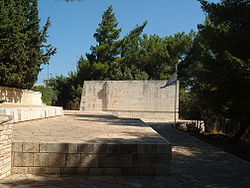- Metzudat Koach
-
Coordinates: 33°06′53″N 35°33′22″E / 33.11472°N 35.55611°E
The Metzudat Koach Memorial (Hebrew: מצודת כ"ח, also Nabi Yusha fort) commemorates 28 soldiers who died during the 1948 conquest of a strategically important fort. The fort and observation point is located in the Upper Galilee, close to the tomb of Nabi Yusha.[1] Its name, Koach, has a double meaning: in gematria it corresponds to 28 (the number of fallen soldiers), and the Hebrew word "כח" meaning "strength".
The Metzudat Koach memorial is currently part of the Israel National Trail, while the fort serves as an Israel Border Police base.[2]
Contents
History
The fort is not a "Tegart fort" — it is not as large as a Tegart and has a round turret. Commissioned by the British and constructed by Solel Boneh, the fort was a key observation point on the Naftali heights, overlooking the Hula Valley, and used to monitor the Palestine/Lebanon border.
By mid-April 1948, the British army had evacuated most of Upper Galilee. A number of key points were subsequently occupied by Arab forces, including the police fort at Nabi Yusha. This fort commanded the main road to Upper Galilee and the routes to the Jewish settlements of Ramot Naftali and Manara. The Palmach understood that this observation point had a strategic importance for the safety and future of the kibbutzim below.
In the evening hours of April 15 , the police station was attacked by a company composed of Golani, Palmach and irregulars from nearby Jewish settlements, which moved in two armoured cars and two armoured Egged buses. Strong fire was opened on the attacking force which was compelled to withdraw. 4 Jews were killed.
On April 20, a second attempt was made to occupy the fort by a force from the third Palmach battalion. A small force succeeded in breaking the barriers and reaching the wall but two of its members were hit, which delayed the detonation of the explosives until their evacuation. During their evacuation, enemy fire was directed at them and many of the unit soldiers were killed. The troops fought to their last man. Altogether, 22 Jews were killed in the battle.
During the night of May 16-17, a company of the third battalion of the Yiftach Brigade occupied the fort after driving away their enemy. On the next day, two of the soldiers were killed.
In the battles for the occupation of the fort 28 Jewish soldiers fell and "Metzudat Hakoach" (Fort of the 28) is named after them today.[3]
The 28 fallen soldiers
Date Name Age Rank Birthplace[4] 20/04/48 Akerman Amnon 19 Private Haifa Ohali Yosef 20/4/48 Barzilai Aryeh 19 Private Lithuania 13/05/48 Ben Nevet Eliezer 21 Corporal Turkey 17/05/48 Ben Bassat Meir 20 Private Bulgaria, Plovdiv 20/04/48 Horowitz Zvi 19 Private Haifa 20/04/48 Wissotzky Nehemia 20 Private Jerusalem 20/04/48 Tolitzinsky Yuval 19 Private Haifa 20/04/48 Yekutieli Amnon 19 Corporal, Squad commander Jerusalem 20/04/48 Yizraelowitz Yitczhak 25 Private Poland 20/04/48 Cohen Avraham 18 Private Jerusalem 20/04/48 Kochba Hanan 19 Private Germany 22/04/48 Levinsky Yisrael 19 Private Poland 20/04/48 Moskowitz Malachi 19 Private Tel Aviv 20/04/48 Mizrachi Shlomo 19 Private Jerusalem 20/04/48 Neeman Moshe 19 Corporal Tel Aviv 15/04/48 Stashi Moshe 18 Private Bulgaria, Sofia 20/04/48 Amikam Boaz 19 Private, paramedic Haifa 20/04/48 Armoni Yizhar 18 Private Jerusalem 20/04/48 Friedman Filon 18 Private Poland Fute Eliezer 20/02/48 Cherkaskyrman David 22 Lieutenant, Platoon commander Haifa 20/04/48 Rauch Mordechai 26 Private Poland 20/02/24 Shevet Eliezer 20 Private Nahala 20/02/24 Shwartz David 26 Private Czechoslovakia 15/04/48 Gutman Joseph 20 Private Tel Aviv 20/04/48 Ahali Joseph 20 Corporal Gedera 20/04/48 Poterman Eliezer 18 Corporal Poland, Nova Korsha External links
References
- ^ http://www.postcardsfromisrael.com/north.html Northern Exposure
- ^ The Koach Fortress by Peter Abelow
- ^ palmach.org.il Palmach Info Center
- ^ http://www.palmach.org.il/show_item.asp?itemId=8519&levelId=42855&itemType=0
Categories:- Forts in Israel
- History of Palestine
- Tegart forts
Wikimedia Foundation. 2010.



